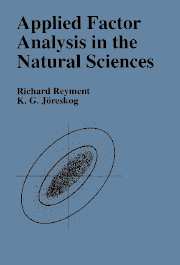Book contents
- Frontmatter
- Contents
- Preface
- Glossary of the most commonly used symbols
- Preface to first edition
- 1 Introduction
- 2 Basic Mathematical and Statistical Concepts
- 3 Aims, Ideas, and Models of Factor Analysis
- 4 R-Mode Methods
- 5 Q-Mode Methods
- 6 Q-R-Mode methods
- 7 Steps in the Analysis
- 8 Examples and Case Histories
- Appendix: Computer programs
- Bibliography
- Index
8 - Examples and Case Histories
Published online by Cambridge University Press: 12 November 2009
- Frontmatter
- Contents
- Preface
- Glossary of the most commonly used symbols
- Preface to first edition
- 1 Introduction
- 2 Basic Mathematical and Statistical Concepts
- 3 Aims, Ideas, and Models of Factor Analysis
- 4 R-Mode Methods
- 5 Q-Mode Methods
- 6 Q-R-Mode methods
- 7 Steps in the Analysis
- 8 Examples and Case Histories
- Appendix: Computer programs
- Bibliography
- Index
Summary
INTRODUCTION
In this chapter, we present applications of the methods we have taken up in this book. We want you to appreciate right at the outset that we have not tried to cover all facets of factor analysis in the natural sciences, our aim being to give you samples of what various specialists have done when faced with particular problems requiring some kind of factor analysis in their solution. Many more applications occur in the literature and it is expected that, armed with the knowledge imparted to you by our book, you will be able to avail yourselves of special slants devised in answer to special problems.
You will notice that we have given much space to Q-mode analysis, a reflection of its exceptional usefulness in many spheres of geological and biological research.
R-MODE PRINCIPAL COMPONENTS IN MINERAL CHEMISTRY
Statement of the problem
The chemically complex minerals of the amphibole set may consist of as many as 12 ingredients. Some of the elements occupy two or more dissimilar structural sites as, for example, Al, which may be located at the tetrahedral T1 and T2 sites and some of the M positions. As another example, we may take Na, which can occupy M4 and/or A sites. These substitutional relationships may be caused by a variety of short– or long–term effects in the crystal structure and various kinds of mutual correlations are identifiable in the concentrations of the elements.
Material
Saxena and Ekström (1970) considered relationships in 639 calcic amphiboles.
- Type
- Chapter
- Information
- Applied Factor Analysis in the Natural Sciences , pp. 228 - 288Publisher: Cambridge University PressPrint publication year: 1993

